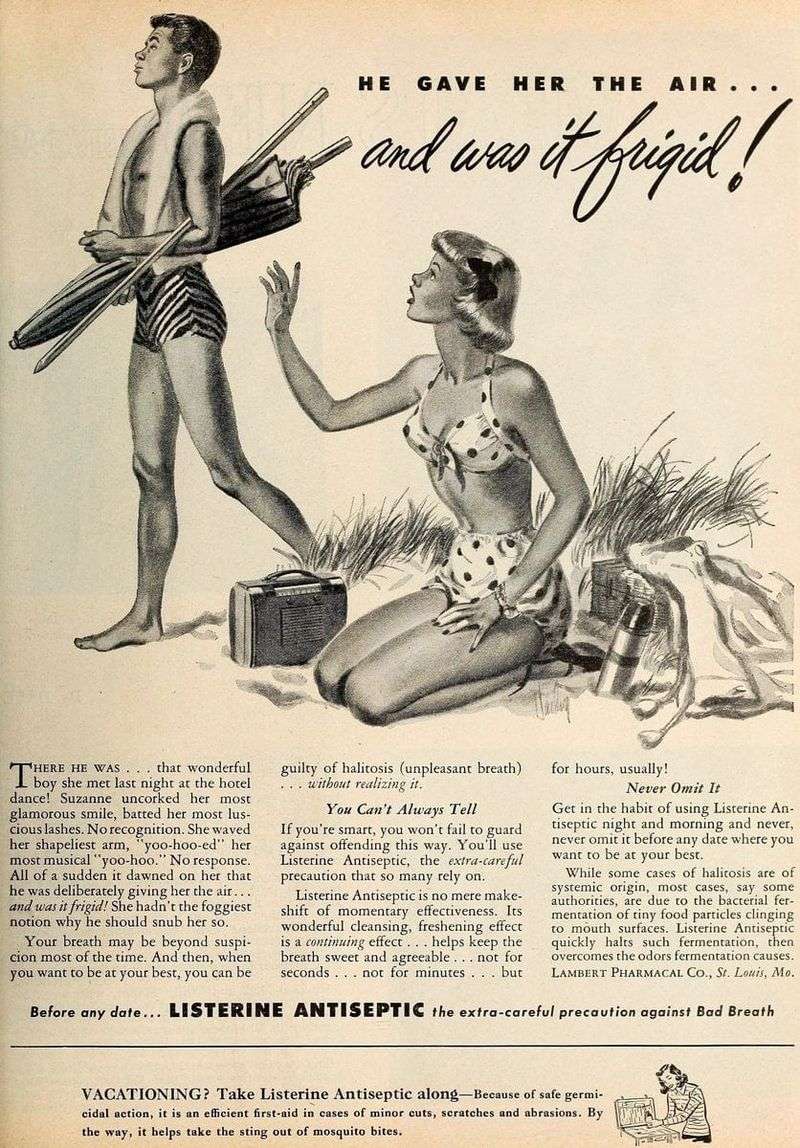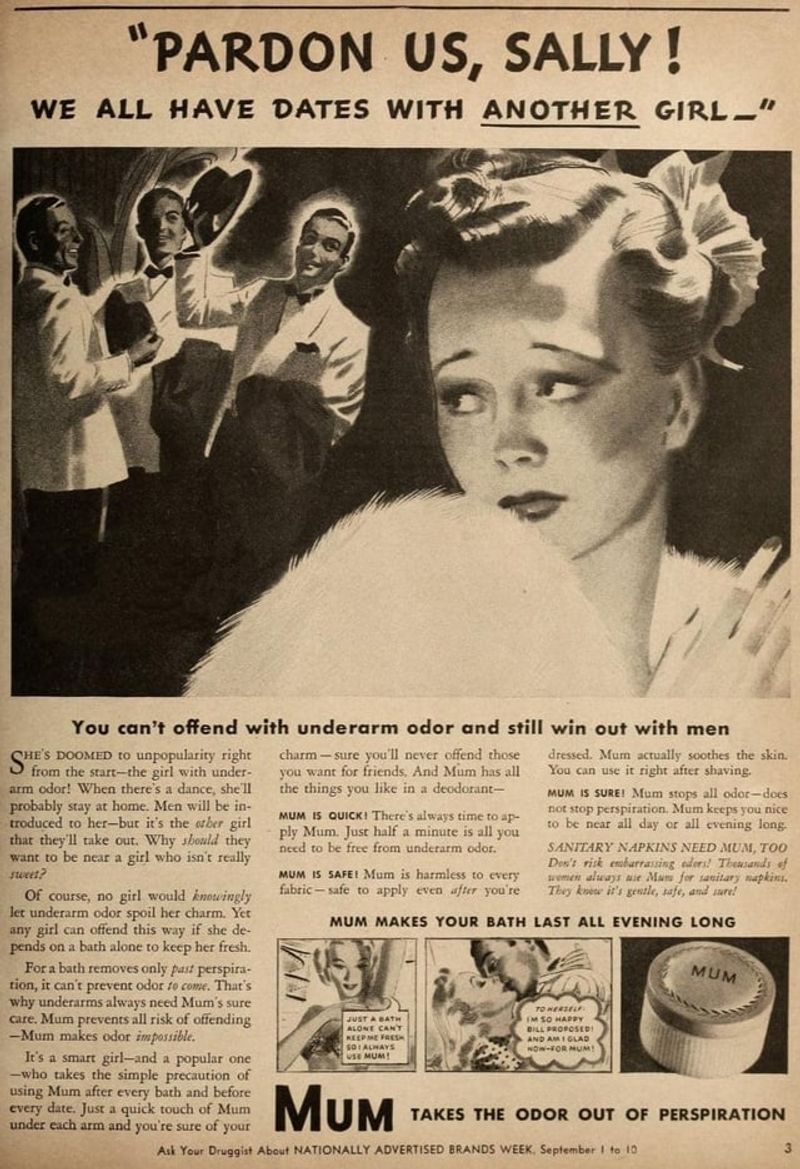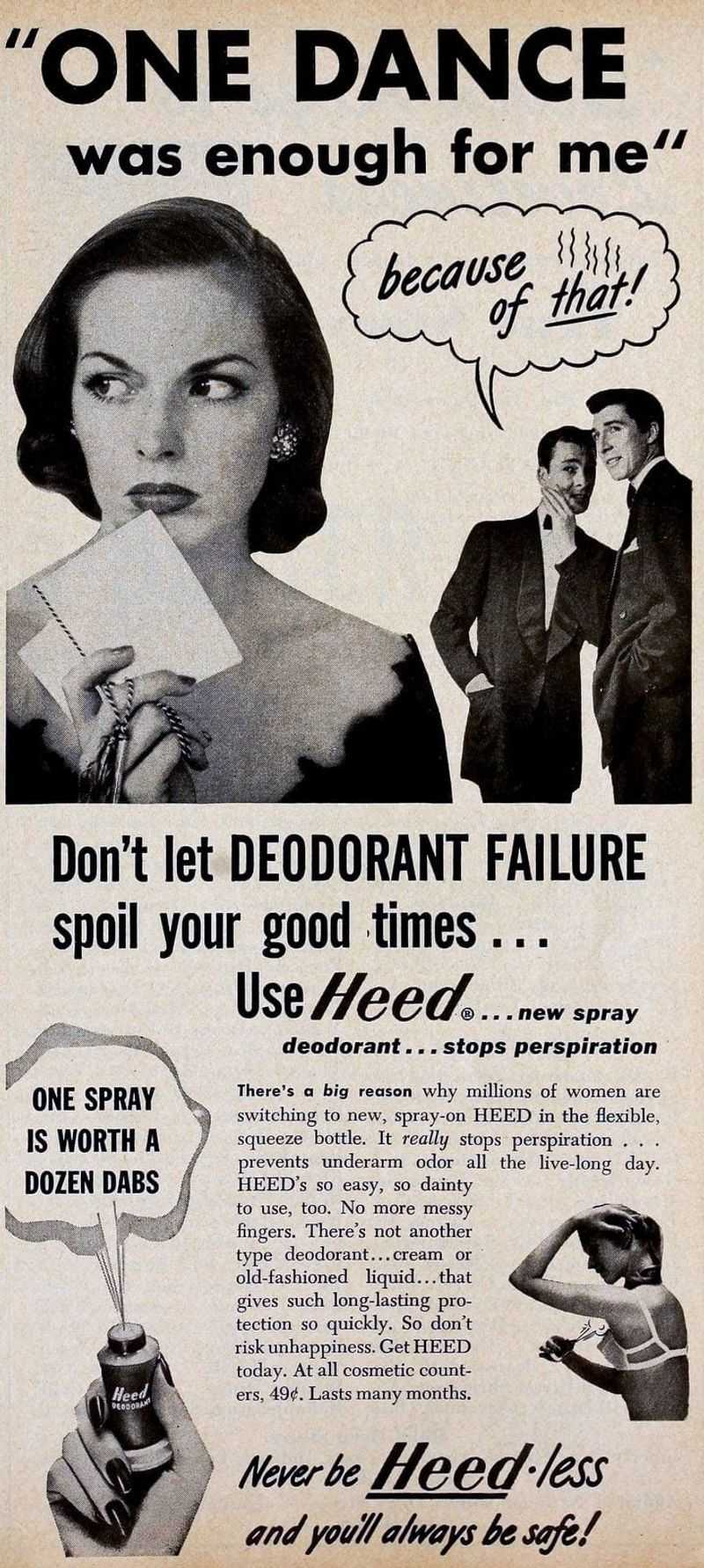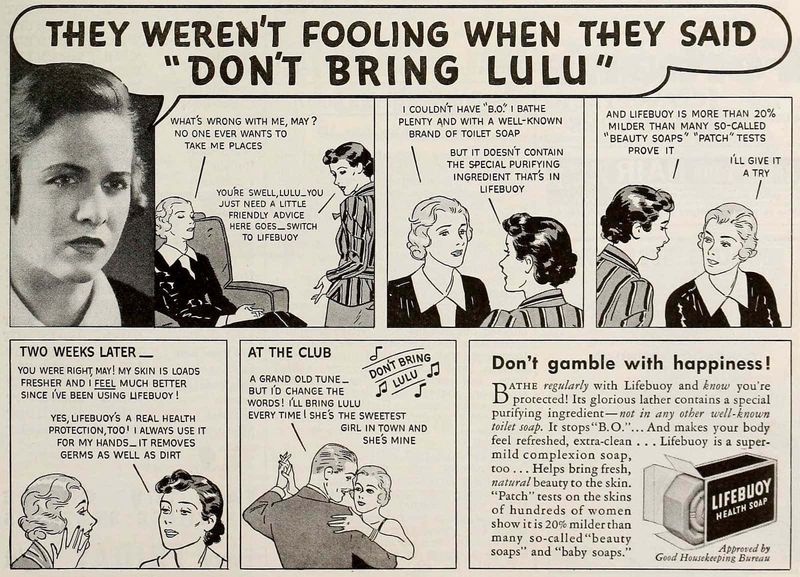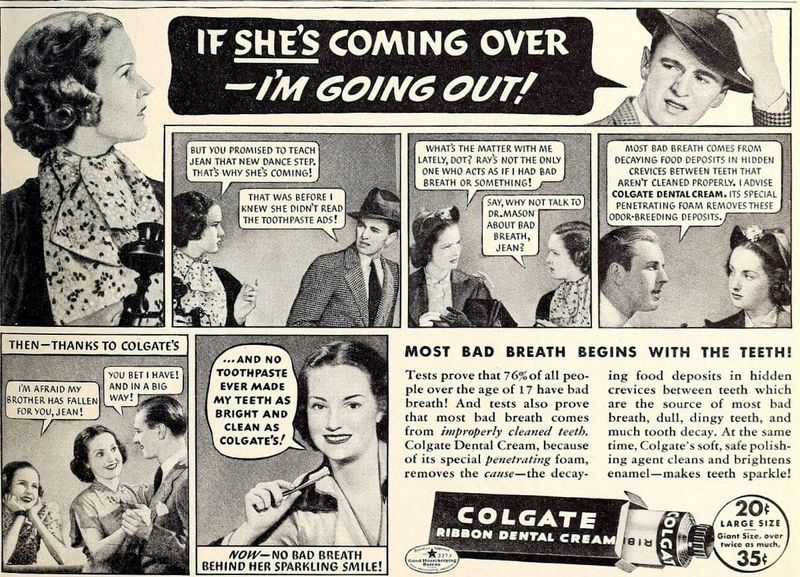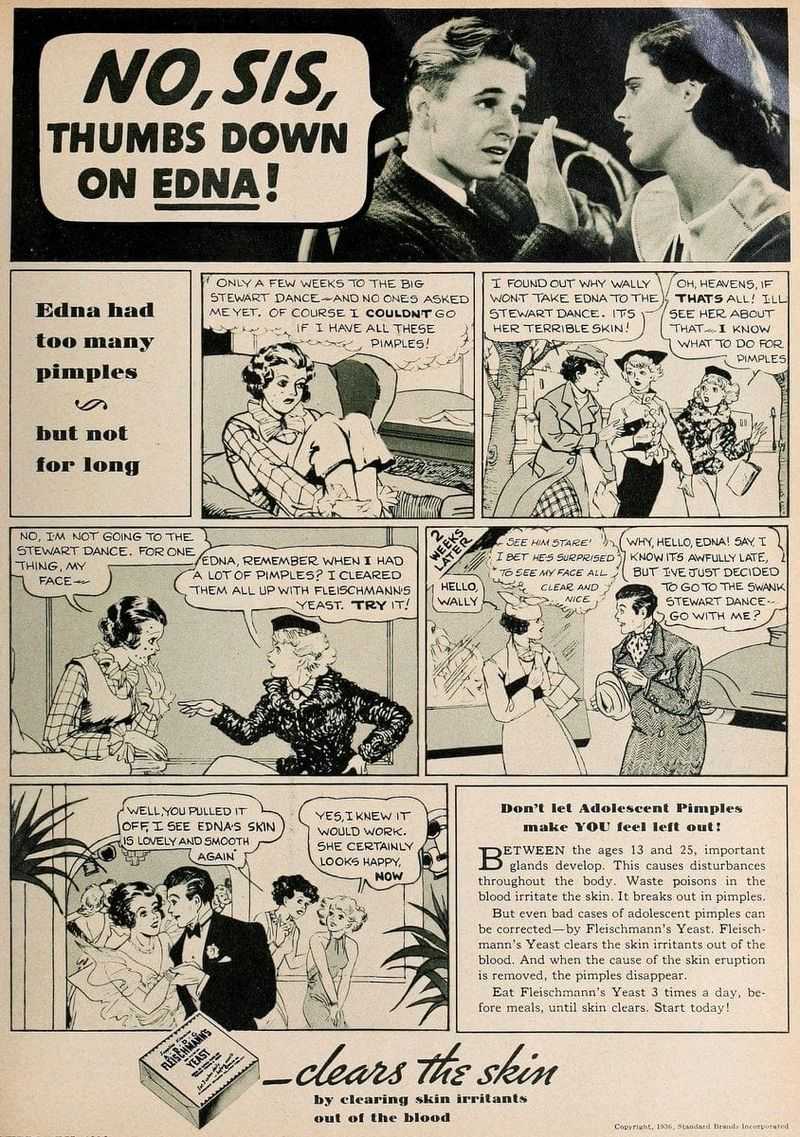The advertising world has evolved enormously over the years, but vintage ads often reveal a stark contrast with today’s standards. This article explores 12 outrageously offensive vintage advertisements that not only shock but also reflect the societal attitudes of their time.
From personal hygiene scares to blatant sexism and racism, these ads, while offensive, provide a telling snapshot of the past. Each advertisement holds its own unique absurdity, making one wonder how such messages ever reached the public eye. Let’s delve into these relics of advertising history and see how far we’ve come.
1. 1951 – “Let the tide take her out… I WON’T!”
In the 1950s, a trip to the beach could quickly turn into a social disaster—or so claimed this Listerine ad. The tagline, “Let the tide take her out… I WON’T!”, warned women that bad breath could leave them friendless under the sun. The ad depicted a lone woman on the beach, surrounded by groups of friends who kept their distance, visibly repelled by her breath. This fear-mongering tactic played on social anxieties, suggesting that personal relationships could crumble due to halitosis. A stark reminder of how marketing once preyed on insecurities.
2. 1955 – “Go out with him? Don’t make me laugh!”
This 1955 Listerine ad aggressively targeted young women, warning them of the social perils of bad breath. The phrase “Go out with him? Don’t make me laugh!” suggested that halitosis was the ultimate social faux pas. The ad featured a teenage girl dismissing a potential suitor, emphasizing that without Listerine, no girl could maintain her social standing. The message was clear: fear bad breath over all other shortcomings. Such adverts exploited youthful insecurities, encouraging a culture of fear around personal hygiene that was prevalent at the time.
3. 1949 – “He gave her the air… and was it frigid!”
In 1949, Listerine continued its campaign against bad breath with the “He gave her the air… and was it frigid!” narrative. This ad dramatized a date scenario where a man coldly rejects his partner due to her breath. Set in an elegant restaurant, the visual showed a woman left alone, clutching her Listerine bottle in despair. The ad aimed to instill fear and urgency around oral hygiene, using social rejection as a powerful motivator. This approach not only sold mouthwash but also reinforced societal pressures of maintaining perfect personal standards.
4. 1940s – “Pardon us, Sally! We all have dates with ANOTHER girl”
In the 1940s, deodorant companies weren’t shy about shaming. The ad “Pardon us, Sally! We all have dates with ANOTHER girl” used social exclusion to highlight the severity of underarm odor. Sally, the unfortunate protagonist, finds herself isolated at a dance, her friends making excuses to avoid her. This dramatic portrayal emphasized that body odor could lead to social exile. It played heavily on the social dynamics of the era, making deodorant an essential part of daily life for those wanting to avoid Sally’s fate, turning personal care into a public concern.
5. 1950 – “One dance was enough for me… because of that!”
The 1950 ad for Heed deodorant was a lesson in public embarrassment. With the line “One dance was enough for me… because of that!”, the ad suggested that underarm odor was an unforgivable offense. The scene depicted a man stepping away in disgust after a dance, leaving his partner blushing with humiliation. Such adverts were designed to create panic and urgency about body cleanliness. By linking personal hygiene with social acceptance, these ads sold more than a product—they sold fear of rejection, making deodorant a must-have item for anyone wishing to avoid social faux pas.
6. 1950 – “Don’t bring Lulu.”
In 1950, Lifebuoy soap crafted a narrative of exclusion with its “Don’t bring Lulu” advertisement. The ad depicted a woman, presumably named Lulu, whose personal hygiene was so lacking that she was uninvited from social gatherings. This portrayal tapped into deep-seated fears of social ostracism, linking cleanliness directly to happiness and acceptance. By suggesting that soap could make or break one’s social life, Lifebuoy cleverly positioned itself as essential to maintaining one’s public image. The ad’s implicit message was clear: neglect personal hygiene, and suffer social abandonment.
7. 1950s – “If she’s coming over — I’m going out!”
The 1950s saw Colgate toothpaste using stark imagery to promote oral hygiene with the tagline, “If she’s coming over — I’m going out!” This ad depicted a family member dramatically leaving the house to avoid the embarrassment of a relative’s bad breath. Set in a quaint 1950s kitchen, the scene underscored the importance of fresh breath for maintaining family harmony. This fear-based marketing capitalized on the anxiety of personal flaws affecting familial relationships, reinforcing the notion that a tube of toothpaste held the key to social acceptance.
8. 1935 – “Don’t ask Mabel — her skin gives me the willies!”
In 1935, Fleischmann’s Yeast targeted skin insecurities with its ad, “Don’t ask Mabel — her skin gives me the willies!” Featuring a woman named Mabel excluded from a social event due to her blemishes, the ad linked skin imperfections to poor health, implying that unenlightened dietary choices were to blame. This advertisement capitalized on the belief that beauty equated to social success. By presenting Fleischmann’s Yeast as a solution, it promised not only clear skin but also a ticket to social inclusion, preying on the vulnerability of individuals concerned about their appearance.
9. 1936 – “No, Sis – thumbs down on Edna!”
The 1936 Fleischmann’s Yeast ad, “No, Sis – thumbs down on Edna!”, took aim at adolescent insecurities. Featuring a teenager named Edna facing peer rejection because of acne, the ad implied that clear skin was synonymous with acceptance. By promoting its yeast supplement as a solution, it played into the era’s obsession with flawless skin. This marketing strategy exploited the vulnerability of teenagers, suggesting that social scars ran deeper than those on the skin. It reinforced the idea that dietary improvements were the pathway to social approval and self-worth during a critical developmental stage.
10. 1930s – “Lysol for the neglect that sometimes kills romance!”
Lysol’s 1930s ad, “Lysol for the neglect that sometimes kills romance!”, controversially marketed its disinfectant as a feminine hygiene product. This shocking usage hinged on the fear of “offensive” odors destroying intimacy. The visual depicted a distressed couple in their bedroom, suggesting Lysol as the savior of romance. By exploiting intimate concerns and insecurities, this ad crossed ethical lines typical of its era. It emphasized a misguided belief in extreme hygiene measures, reflecting how far advertisers would go to capitalize on personal fears, turning a cleaning product into a bizarre solution for romantic woes.
11. 1940s – “Lighten your look to win his favor”
The 1940s fairness cream ad, “Lighten your look to win his favor,” blatantly capitalized on racist beauty standards. Set in a beauty salon, the ad showed a woman eagerly applying cream, influenced by societal pressures equating lighter skin with attractiveness and social worth. Such advertisements perpetuated harmful stereotypes, suggesting that skin tone dictated personal success and romantic desirability. This portrayal not only reinforced racial biases but also exploited insecurities, pushing products that promised transformation. The legacy of these ads serves as a potent reminder of the pervasive impact of advertising on societal values and self-image.



